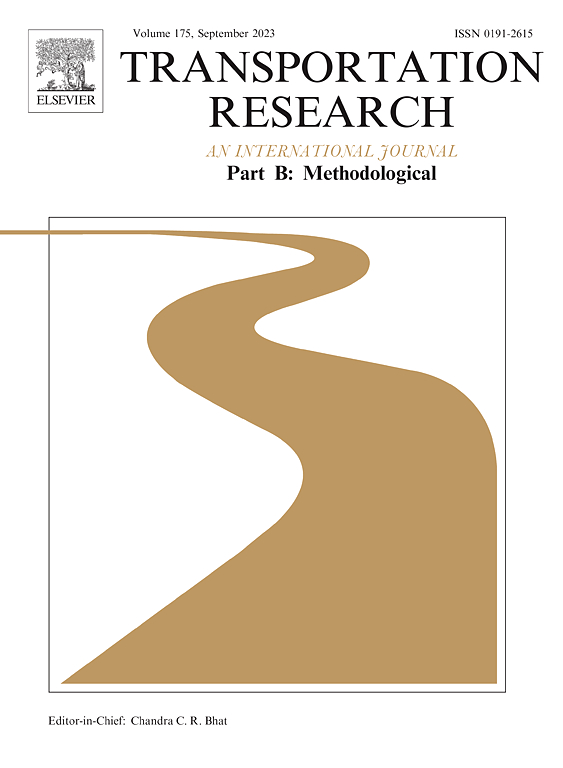基于代理模型的干扰后车道反转优化提高城市交通弹性
IF 6.3
1区 工程技术
Q1 ECONOMICS
引用次数: 0
摘要
考虑到车辆流量和网络供应之间复杂的相互作用,中断后的快速恢复至关重要,但也具有挑战性。基于仿真的方法被广泛用于帮助规划者在恢复措施优化中获得真实的用户-系统交互,尽管将其应用于大规模交通网络的计算成本仍然很高。本研究探讨了使用代理模型作为资源密集型模拟的时间效率替代方案的可行性。采用车道反转控制作为一种新的恢复措施,建立了系统恢复优先级的优化框架。采用基于宏观基本图(MFD)动力学的弹性损失指标来评价交通运输系统的实时性能。因此,所提出的替代模型也侧重于近似恢复评价指标,即恢复力损失,而不是链接流量和密度。代理模型包括一个动态分析网络模型和一个高斯过程回归模型。前者提供了分析弹性损失,并考虑了由时变车道反转决策引起的网络变化的时间相关性。后者捕获了模拟和分析弹性损失之间的差异。实验是在京都的一个大型现实道路网络上进行的。在15条和20条可控链路的情况下,该方法仅需要5次算法迭代,仅需要150次模拟运行,就可以减少约6%的交通弹性损失,证明了其有效性。我们还说明了恢复性能和控制资源之间的权衡,考虑到决策持续时间短和计算预算非常紧张,更多的可控链接不必要地提供更好的弹性改进。本文章由计算机程序翻译,如有差异,请以英文原文为准。
Post-disruption lane reversal optimization with surrogate modeling to improve urban traffic resilience
Rapid post-disruption recovery is essential but challenging, given the complex interactions between vehicular flows and the network supply. Simulation-based methods are widely used to assist the planner with realistic user-system interactions in the recovery measure optimization, though the application to large-scale transportation networks remains computationally expensive. This study explores the feasibility of using surrogate models as a time-efficient alternative to resource-intensive simulations. Lane reversal control is employed as a novel recovery measure and an optimization framework prioritizing systematic recovery is developed. A resilience loss indicator based on macroscopic fundamental diagram (MFD) dynamics is used to evaluate the real-time performance of the transportation system. The proposed surrogate model, therefore, also focuses on approximating recovery evaluation indicators, i.e., the resilience loss, other than link flows and density. The surrogate model contains a dynamic analytical network model and a Gaussian process regression (GPR) model. The former provides the analytical resilience loss and considers the temporal correlation of network changes resulting from time-dependent lane reversal decisions. The latter captures the difference between simulated and analytical resilience losses. Experiments are conducted on a large real-world road network in Kyoto City. The proposed approach demonstrates its efficacy by mitigating traffic resilience loss by about 6% under scenarios of 15 and 20 controllable links with a mere five algorithm iterations, requiring only 150 simulation runs. We also illustrate a trade-off between recovery performance and control resources that more controllable links unnecessarily offer better resilience improvement given the short decision-making duration and the very tight computational budget.
求助全文
通过发布文献求助,成功后即可免费获取论文全文。
去求助
来源期刊
CiteScore
12.40
自引率
8.80%
发文量
143
审稿时长
14.1 weeks
期刊介绍:
Transportation Research: Part B publishes papers on all methodological aspects of the subject, particularly those that require mathematical analysis. The general theme of the journal is the development and solution of problems that are adequately motivated to deal with important aspects of the design and/or analysis of transportation systems. Areas covered include: traffic flow; design and analysis of transportation networks; control and scheduling; optimization; queuing theory; logistics; supply chains; development and application of statistical, econometric and mathematical models to address transportation problems; cost models; pricing and/or investment; traveler or shipper behavior; cost-benefit methodologies.

 求助内容:
求助内容: 应助结果提醒方式:
应助结果提醒方式:


